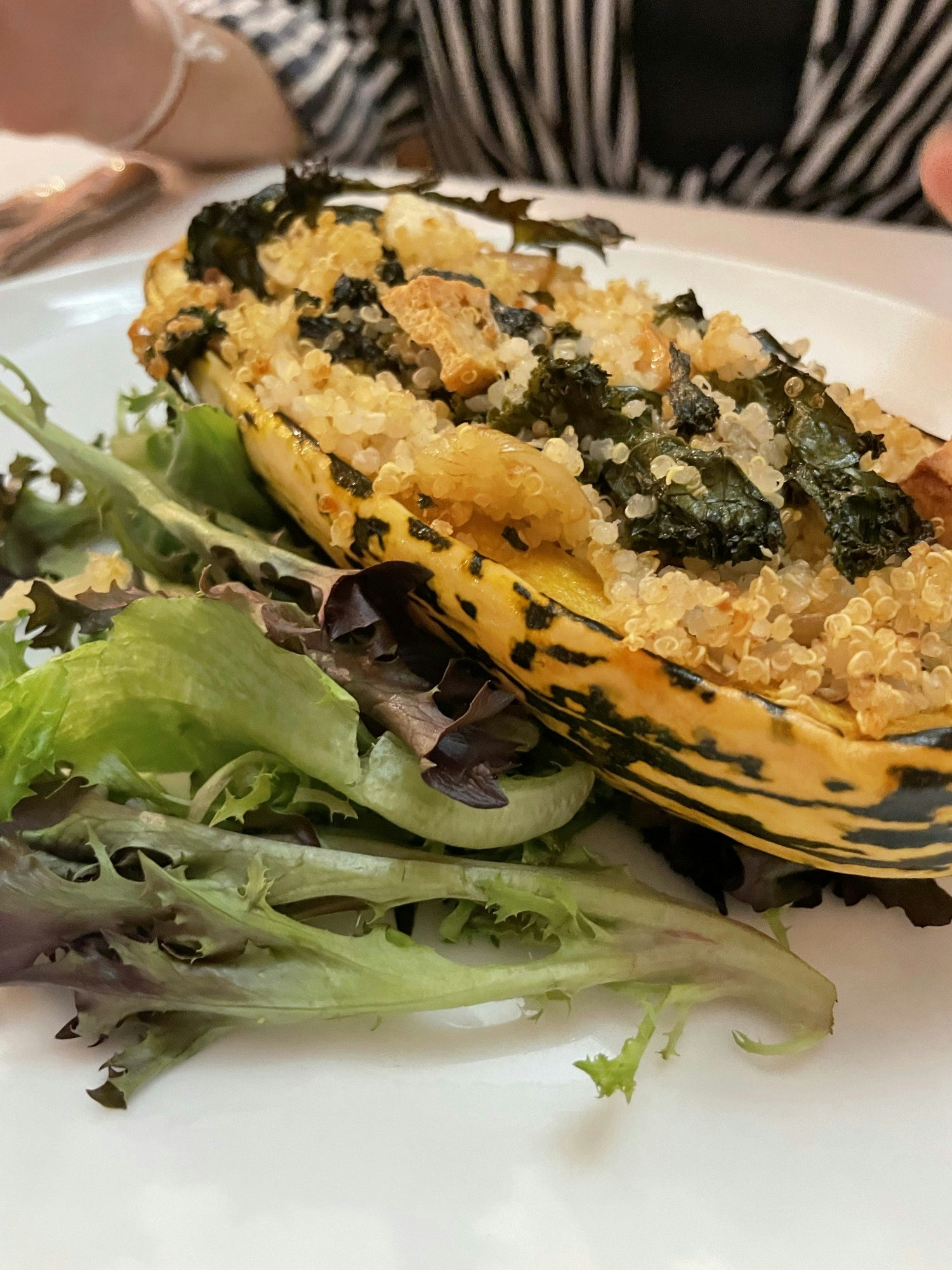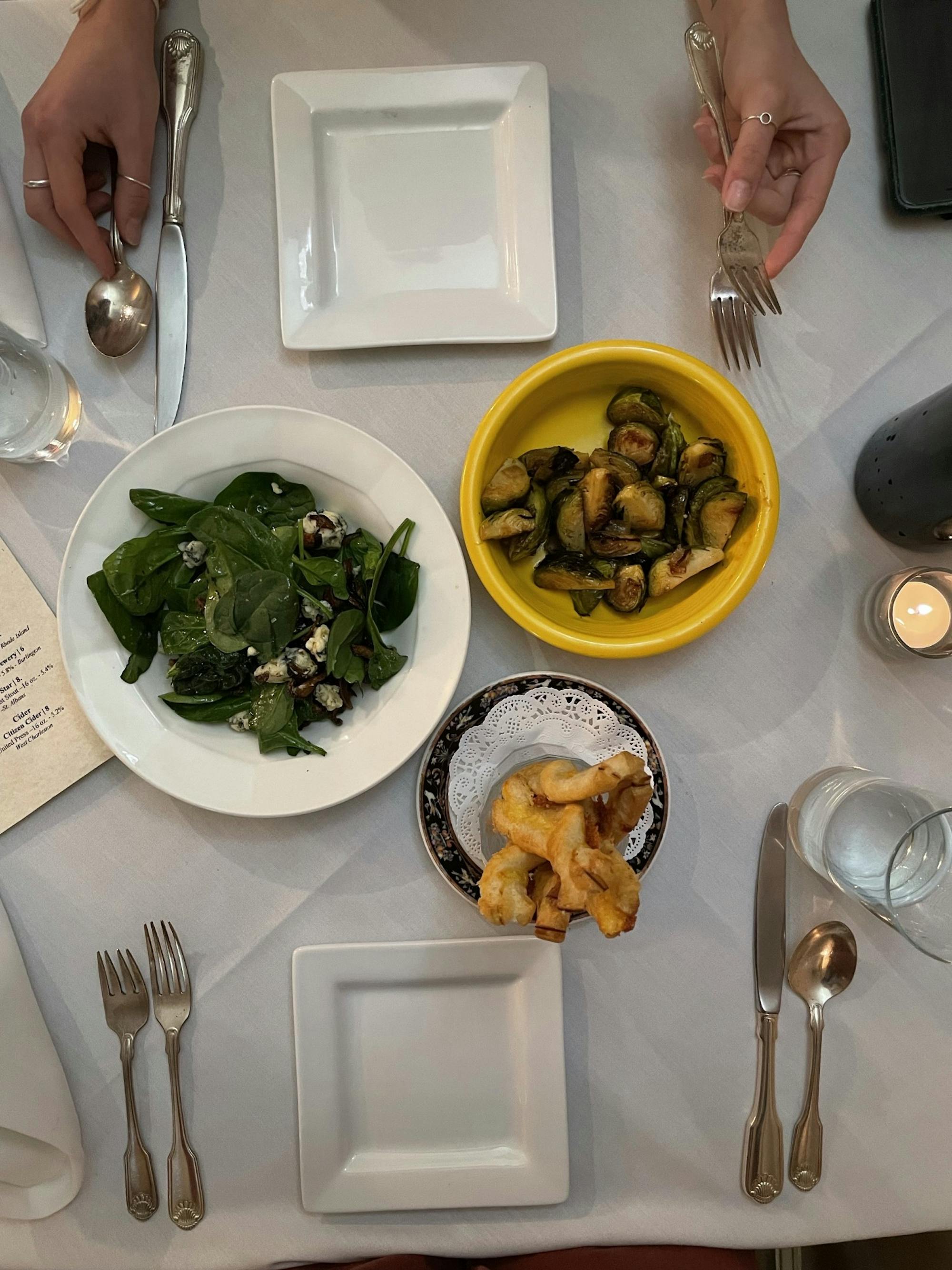This past weekend, I crossed the Connecticut River and visited the town of Norwich. A friend told me about a great restaurant there called Carpenter and Main. The fact that Bruce MacLeod, chef and owner of the restaurant, graduated from Dartmouth in 1984 piqued my interest, so I eagerly called the restaurant to make my reservation.
Like many other Dartmouth students, my geographic awareness does not extend beyond the bounds of Hanover. When I looked up the directions to Carpenter and Main, I didn’t realize it was a five-minute drive across the bridge from campus. As MacLeod would later tell me, some students walk all the way to the restaurant during the summer. Out of all the restaurants I’ve reviewed in the Upper Valley, this is easily the most accessible one transportation-wise.
I arrived at 8:15 pm. A tree near the entrance was decorated in warm lights, and upon entry, there was an antechamber to place your jacket and belongings. A sign saying “Person” hung on the bathroom door (as a nonbinary person, this earned bonus points from me). Afterwards, I entered the main dining area. A waiter guided me and my partner down the third hall to a little room at the back left of the main building. In total, I saw three dining rooms: the first, a large, low-lit bar room with brick-red walls and dark wooden chairs; the second, a dark elegant room that seemed a bit more private than the first; and the third, the room in which we were seated.

It took the style of a classic New England living room. Warm and cool lotus-shaped lights hung from the light-pink walls and balanced each other out, illuminating the oil-paintings of New England landscapes and a large fireplace at the center of one wall. Above the fireplace, a large mirror hung that opened the physical space of the room; at its sides, two cozy nooks hid from the rest of the room, allowing for an even more private experience. Around the fireplace, pumpkins, dried wheat and rustic reds and oranges gave light to the restaurant’s seasonal autumn aesthetic. Besides the two nooks, there were only three tables in the room. It feels relaxing and intimate.
Our server, Eric, brought us a standard size wine bottle full of water and proceeded to light a candle at our table. The tablecloths were spotlessly white and the cutlery had a weight to it that I really appreciated. I couldn’t hear any music from this dining room, but the light chatter coming from the two tables gave yet another sense of warmth to the room. The other guests seemed to be regulars from how they talked to their server. On the drinks menu, house cocktails like the “Ping Pong Cocktail” called to mind Dartmouth pong and the restaurant’s proximity to campus. The menu had some vegetarian options, and I ordered the ones that seemed the most appealing: the “Cheddar Cheese Puff Sticks,” “Maple Cider Brussels Sprouts,” a spinach salad and a roasted delicata squash.
The cheddar puff sticks came out first, followed by the brussels sprouts and the spinach salad. The puff sticks, vertically stacked in a small glass, consisted of a half-dozen, 6-inch long, lightly-baked puff pastry sticks with a stream of baked cheddar down the middle. The taste was incredible. The light airiness of the puff pastry, with its buttery sweetness, complemented the crunchy saltiness of the baked cheese. For a $7 appetizer, I really enjoyed it, and had to resist ordering more.
The brussels sprouts were beautifully roasted, and they unfurled during baking, allowing for the maple cider glaze to infuse every layer. Their sweetness balanced out the natural bitterness, and the cider added an unexpected but pleasant citrusy aftertaste. I’d recommend these to anyone over the brussels sprouts at Foco. For a $7 dish, however, it would have been nice to see some creativity in texture with almonds or some other neutral, crunchy ingredient.
The spinach salad consisted of spinach, dried shiitake mushrooms, blue cheese and sherry vinaigrette. It was perfectly dressed, as to not overwhelm the other flavors. The shiitake packed a punch of flavor, and their crunch paired well with the creamy, rich blue cheese. As a vegetarian who misses bacon, this combination felt like a solid substitute. Eric, our server, told me the blue cheese was the signature ingredient of the salad, and his statement held true. Sourced locally from Vermont, this Jasper Hill Bayley Hazen Blue cheese was served in large chunks — a risky choice given the general sentiment towards blue cheese. But the creamy nuttiness of the cheese, which melted in my mouth, neutralized the acidity of the vinaigrette. The salad’s $9 price proved its worth with every bite.
Eric then brought out a roasted cauliflower dish; “Compliments of the chef,” he said. It consisted of cauliflower, mixed greens, pecans, grapes and tiny morsels of white cheddar. It was warm, which I enjoyed, and the dish proved to be well-thought out. The cauliflower broke apart easily in my mouth, with some hints of garlic coming through. The grapes added a natural sweetness to the dish, while also balancing out the dry-mouth feel from the pecans. The grapes’ purple skin complemented the purple lettuce in the mixed greens. Finally, the cheddar kicked in at random points, pairing especially well with the sweetness of the grapes. I would not have hesitated to get this dish for $9.

Eric then brought out my entree, the delicata squash. MacLeod aced the presentation on this dish, as evidenced by my gasp when I saw it. The dish was half of a stuffed squash, skin still on, sitting on a bed of mixed greens. The green-yellow contrast pleased the eyes. The quinoa and crispy kale stuffing added a nice texture to the tender squash, and the tofu in the stuffing gave the entree a hearty meatiness. The dish wasn’t very seasoned, and I mean that in the best way possible. It allowed the squash to shine, encapsulating the flavors of fall in Vermont. At $19, it was a bit on the costly side for a vegetarian entree, but every bite of the dish and its visual elegance made it worth it.
Finally, I ordered some desserts to end the night: a maple crème brûlée and a scoop of house-made star anise ice cream. As a crème brûlée lover, I was ready to fully critique this dish. When it came out, though, I knew there’d be nothing to critique. The crust was perfect, solid but not burnt. The custard was neither over nor undercooked. Oftentimes, crème brûlée can be soupy or too flan-like, or even cakey in some instances. Here, it was baked to perfection. Vanilla beans dotted the custard, which speaks to the authenticity of the restaurant. Other than the light yet delicious maple flavor, it was a traditional crème brûlée. In fact, it was the best one I’ve ever had, and for $7. The house-made ice cream ($3 per scoop) shocked me. The heavy, rich, thickness of the cream was irresistible, and the star anise reminded me of my grandmother’s house in Colombia. Like Tuckerbox’s Kunefe, I couldn’t help but smile with each bite of these desserts.
I wholeheartedly recommend Carpenter and Main. It feels like fine dining, but the prices are still pretty affordable. Furthermore, MacLeod hosts $10 Sunday dinners with full courses, as a way to give back to the community during the pandemic. I think a Sunday outing to the restaurant would be a perfect way to spend a night with friends and loved ones. What strikes me most about this restaurant, though, is how well it realizes MacLeod’s goal: “We use goods from local farms year-round to help integrate the spirit and distinctive flavors of Vermont.” From the constantly changing, local menu to the decorations of the dining rooms, MacLeod’s constant attention to his restaurant is ever present and easily noticed. I’ll be coming back for more throughout my studies, and I hope you do the same.
Rating: ★★★★★




